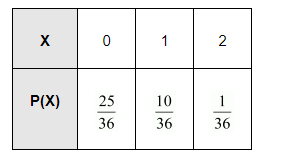Two dice are thrown simultaneously. If X denotes the number of sixes, find the expectation of X.
Here, X represents the number of sixes obtained when two dice are thrown simultaneously. Therefore, X can take the value of 0, 1, or 2.
$\therefore \mathrm{P}(\mathrm{X}=0)=\mathrm{P}$ (not getting six on any of the dice) $=\frac{25}{36}$
P (X = 1) = P (six on first die and no six on second die) + P (no six on first die and six on second die)
$=2\left(\frac{1}{6} \times \frac{5}{6}\right)=\frac{10}{36}$
Therefore, the required probability distribution is as follows.

Then, expectation of $X=E(X)=\sum X_{i} P\left(X_{i}\right)$
$=0 \times \frac{25}{36}+1 \times \frac{10}{36}+2 \times \frac{1}{36}$
$=\frac{1}{3}$
Click here to get exam-ready with eSaral
For making your preparation journey smoother of JEE, NEET and Class 8 to 10, grab our app now.
